Simplified Step-by-Step Guide to Sales Engagement by Zixflow
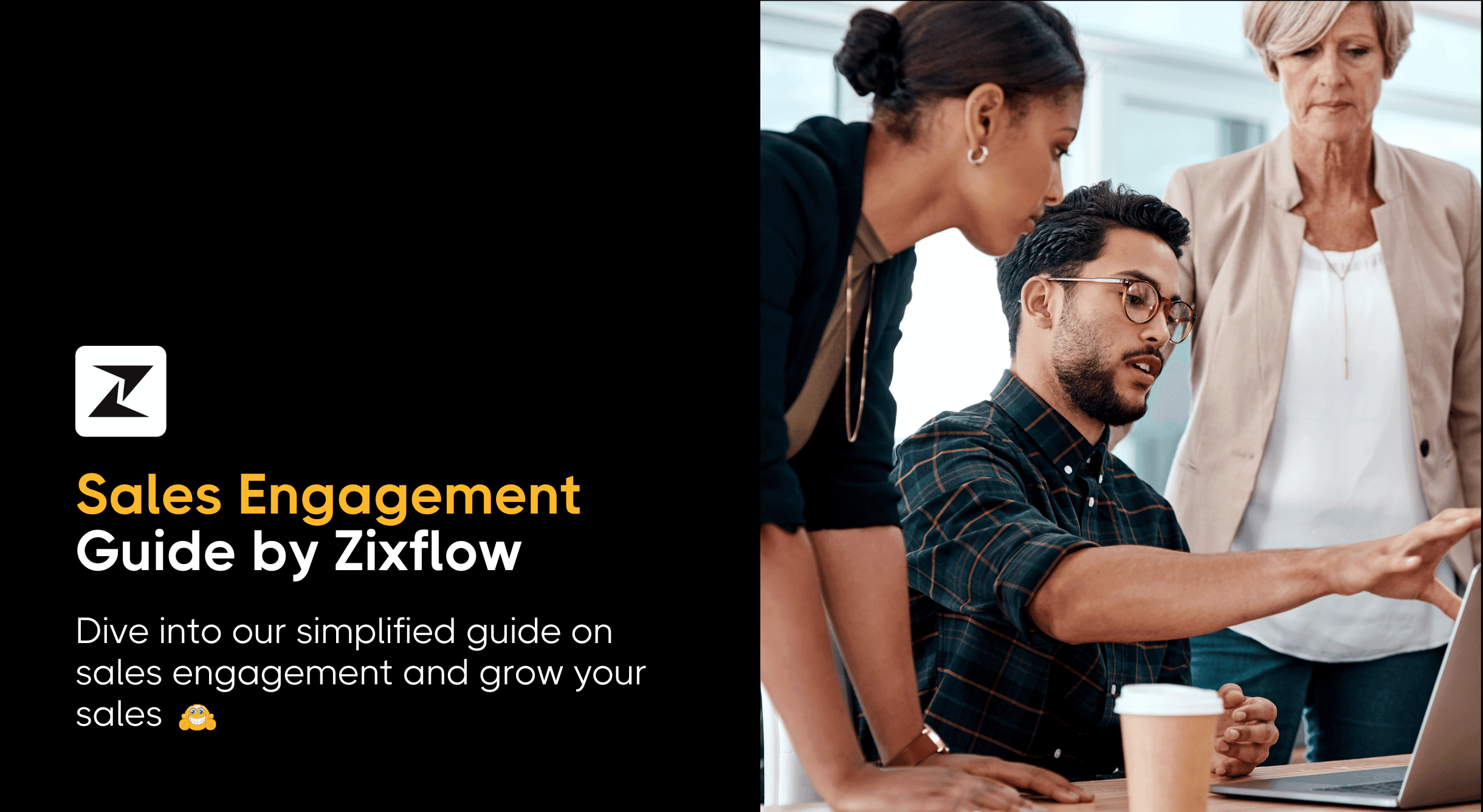
The most vital component of the sales process is engaging prospects and potential customers. However, you must ensure that you follow the right sales engagement model.
The path to successful sales engagement involves various bottlenecks and challenges. From communication inefficiencies to reduced visibility in remote settings, plus improving productivity and outcomes of customer-facing and revenue-generating teams can be a complex affair. In addition to that, keeping yourself updated with the latest sales engagement strategies is crucial as well. You can learn that by keeping up with the latest industry news or through podcasts on sales engagement. But just that will not be enough to handle the complex process of sales engagement.
Thankfully, the correct sales engagement platform can empower your sales teams with the right tools to drive efficiency and productivity to attain desirable outcomes.
But before we start discussing sales engagement software or platforms, let's first discuss what sales engagement is. And the best practices you can incorporate to make the sales engagement process successful.
What is sales engagement?
“It is not your customer’s job to remember you. It is your obligation and responsibility to make sure they don’t have the chance to forget you.” – Patricia Fripp
Sales engagement is the process of interacting and establishing valuable relationships with your potential customers during the sales pipeline.
It encompasses performing research, connecting, nurturing, establishing relationships, and closing deals with qualified sales leads.
Simply put, a successful sales engagement operation represents a step-by-step approach or workflow that enables the sales team to close a deal and generate revenue for your business.
Why is sales engagement important for your business?
Sales engagement is a huge point of attention for companies looking to provide exceptional customers. service and boost revenue.
In fact, as per research by Gartner, over 90% of sales experts are considering putting more money into tools and techniques to empower their sales reps to connect effectively with existing and potential buyers.
After understanding the concept of the sales engagement process, let's take a look at how this process can be beneficial for a business.
Improved lead nurturing
Planning is the cornerstone of success. With a centralized sales engagement process in place, the sales representatives can proceed with lead interaction and nurturing in a streamlined way.
Ultimately, strategized nurturing with proper lead nurturing tools will translate into better chances of conversion and more profit.
Proactive and personalized communication
The most vital component of sales engagement is communication. A sales rep can introduce personalized aspects during interaction by performing extensive research on particular prospects.
Having a predefined sales plan makes the advanced workflows for optimized sales interaction simpler and easier. On top of that, a sales solution like Zixflow can allow you to automate sales workflow and assist you in personalizing your sales engagement process.
Helps in enhanced revenue generation
A well-planned and strategically conceptualized sales engagement process can assist your team in accelerating the sales cycle, getting better skills for effective pitching, improved lead nurturing, enhanced customer satisfaction, and ultimately more conversions.
Consequently, with a smooth sales cycle, you can easily scale up your business. Furthermore, integrating sales engagement software will ensure increased productivity of your sales representatives and translate into generating more revenue for your business.
To unlock all the benefits of the sales engagement process, you must incorporate a comprehensive sales engagement tool and follow the best practices (more on this later.)
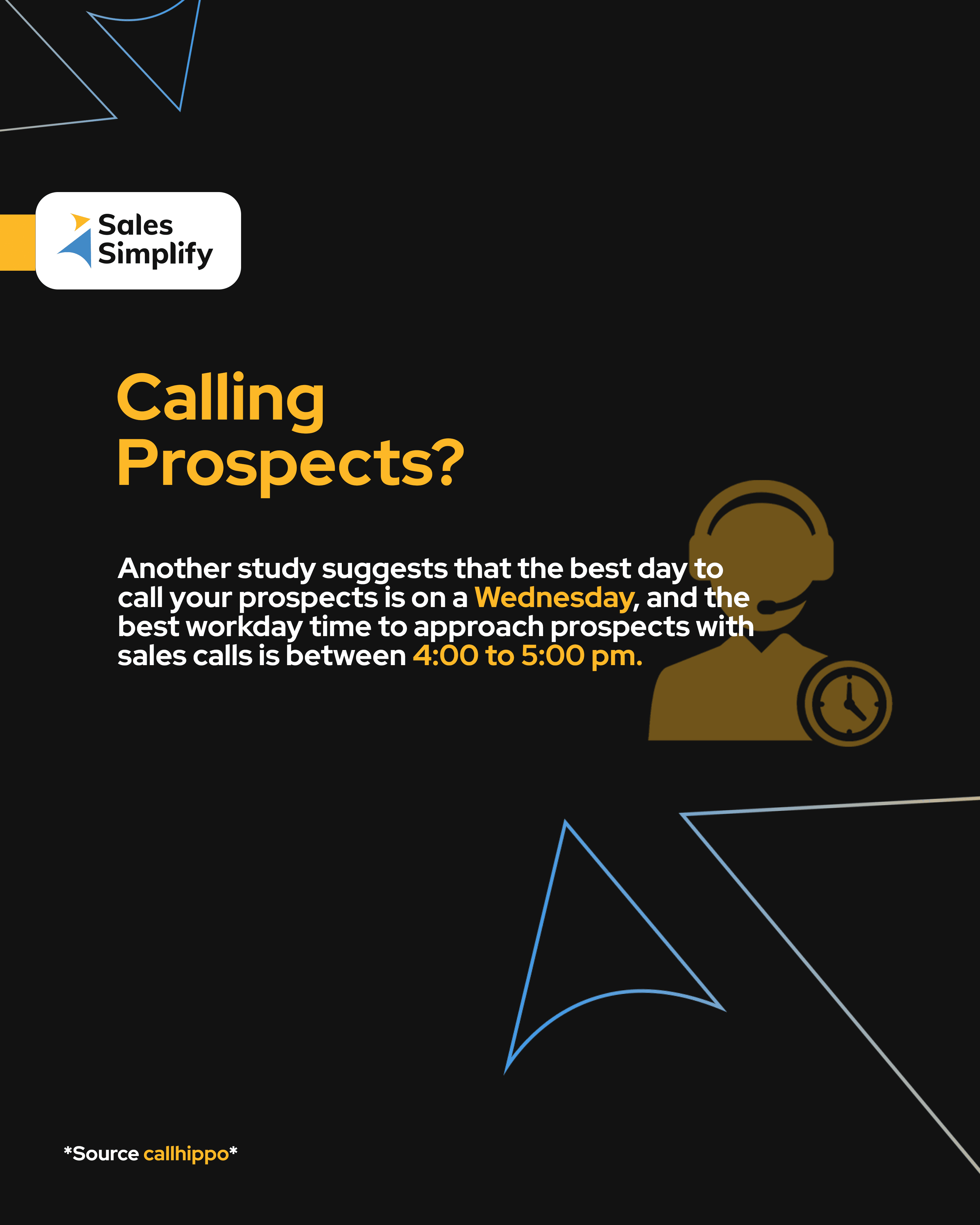
Phases of the sales engagement process
Engagement in the sales process begins with strategizing a comprehensive engagement plan.
The sales engagement plan should highlight the pain points you are trying to address and the techniques your sales team will apply to generate quality leads, influencing them and offering a valuable solution to the particular pain point.
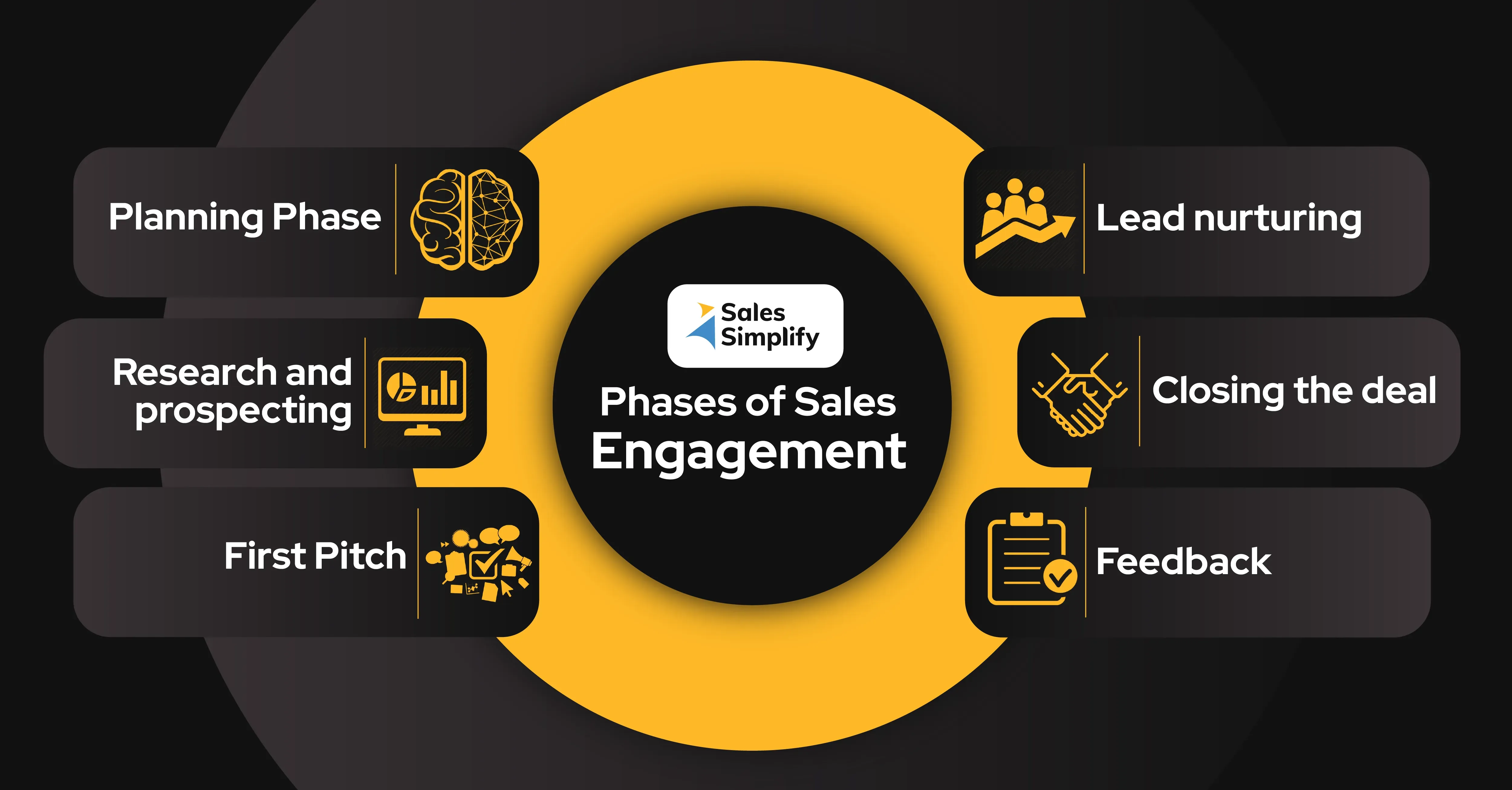
Since sales engagement involves a structured process and includes six stages starting from planning to ultimately closing a deal. Let’s look at each of them in detail.
Planning stage
In the planning stage, the entire team prepares a blueprint for executing the sales engagement process.
The planning stage of the sales engagement is where your entire sales team comes together to figure out what you're going to do. You can use these few questions to determine your goals.
- What are your sales engagement goals?
- How will you measure success?
- Who are the key players involved in the particular sales engagement project?
- What resources do you have access to?
- What is the timeline for this project?
Prospecting and researching
Gather correct information on the target audience before establishing the first touch point. This phase may include a series of questions and answers to understand the target audience's psychology.
Prospecting is the process of finding new opportunities. Researching is the process of gathering information about them.
In sales, these two processes are combined to form a strong pipeline of potential customers for your business. Prospecting is the first step in your overall sales strategy, but it's not enough by itself—you need to research your prospects before you can close them.
You can use a Leadbot and social media outreach activities to search for ideal leads.

In the research process you can use the following questions to dig deeper into your lead psyche:
- What your potential customer wants and how do they want it?
- How much are they willing to spend on that product or service and what’s their budget?
- Will they buy from you or someone else? What’s your competitive situation? What’s the existing relationship of your lead with your competitor companies?
First pitch
First touchpoint made by the SDR or first personalized presentation of your service to the client.
The first pitch is a critical part of any sales engagement. It's the beginning of your relationship with your customer, and it sets the tone for all future interactions.
It is traditionally used to introduce yourself and your product or service. It's an opportunity to show your prospects who you are and what you have to offer, so make sure that it's engaging, interesting, and relatable.
Your first pitch should be short and sweet. But it should include at least three different components: a description of your company, an explanation of how your product or service works, and an example of how it can be used (maybe an example of how it will help them solve their problem).
Lead nurturing
Lead nurturing is the process of Influencing the prospect about your product with valuable information and educational insights.
-
It involves engaging and building relationships with potential clients. It's a great way to get your prospects' attention and make them feel like you're genuinely interested in them as a person, rather than just another number.
-
Lead nurturing can be a simple email sent out to introduce yourself, or it can be an elaborate process that involves many different touch points and interactions with your prospects. It all depends on what you want to accomplish with the lead—and which of your goals are most important.
-
When you nurture leads effectively, they're more likely to become active buyers; when they do become active buyers, they're more likely to stick around as repeat customers and referrals for your business.
Closing the deal
Closing a deal or the closure stage is a critical element of the sales process. When the prospect is confident about your product, they may want to purchase your product.
It's when you get your customer to say yes, and it's when they're committed to doing business with you. That translates into successful closure.
The successful closure has four key elements:
- The customer feels understood
- The customer feels valued
- The customer feels ready to buy
- The customer is willing to pay for the product or service
Here is a quick example of the steps you can follow in the closure phase of the sales engagement process:
- Presentation: You need to clearly explain what you can do for your client and why it's in their best interest to work with you. This includes highlighting features of your product or service that make it unique, as well as showing how it will benefit their business.
- Estimate: After presenting the benefits, you'll need to provide an estimate of how much time it will take to complete this project. This should also include any follow-up tasks that might be needed after delivery has been completed.
- Ask: Once all of these details have been covered and agreed upon by both parties, it's time for final questions about how long things will take before delivery begins!
But, if a lead doesn't convert into a customer, you can tag it as a failed closure. Many sales engagement tools such as Zixflow help you enlist the reasons for failed closure to upgrade and improve your sales engagement strategies in the future.
Feedback stage
Here, irrespective of the outcome (successful or failed closure), the SDR collects reviews from the prospect to improve the product or the next approach respectively.
This can be done in multiple ways: through surveys or questionnaires, as part of a sales conversation, or even through text messaging.
For business leaders, sales managers, and SDEs, a sales engagement platform offers valuable insights to increase the momentum of the sales process.
A quality sales engagement tool can streamline workflows across various engagement stages and models to help individual reps improve productivity.
This video gives a quick outlook on how Zixflow can streamline your sales engagement workflow.
Sales enablement vs. sales engagement
By definition, sales enablement is the process of conceptualization, arrangement, and careful formation of the entire sales team through a proactive process. The sales team is developed to build valuable relationships and generate profit for your business.
The sales enablement process involves the following:
- Recruitment of qualified sales professionals
- Training, upskilling, and motivating them about the organization's values and existing sales procedures.
- Onboarding sales professionals to essential sales platforms.
In comparison, the sales engagement process is executed by sales reps. As mentioned previously, it is dedicated to valuable-exchange interaction and getting the best outcome from their prospects.
The sales engagement process is directly related to the sales enablement process. Therefore, from an organizational perspective, sales engagement is an external process, while the sales enablement process is an internal workflow.
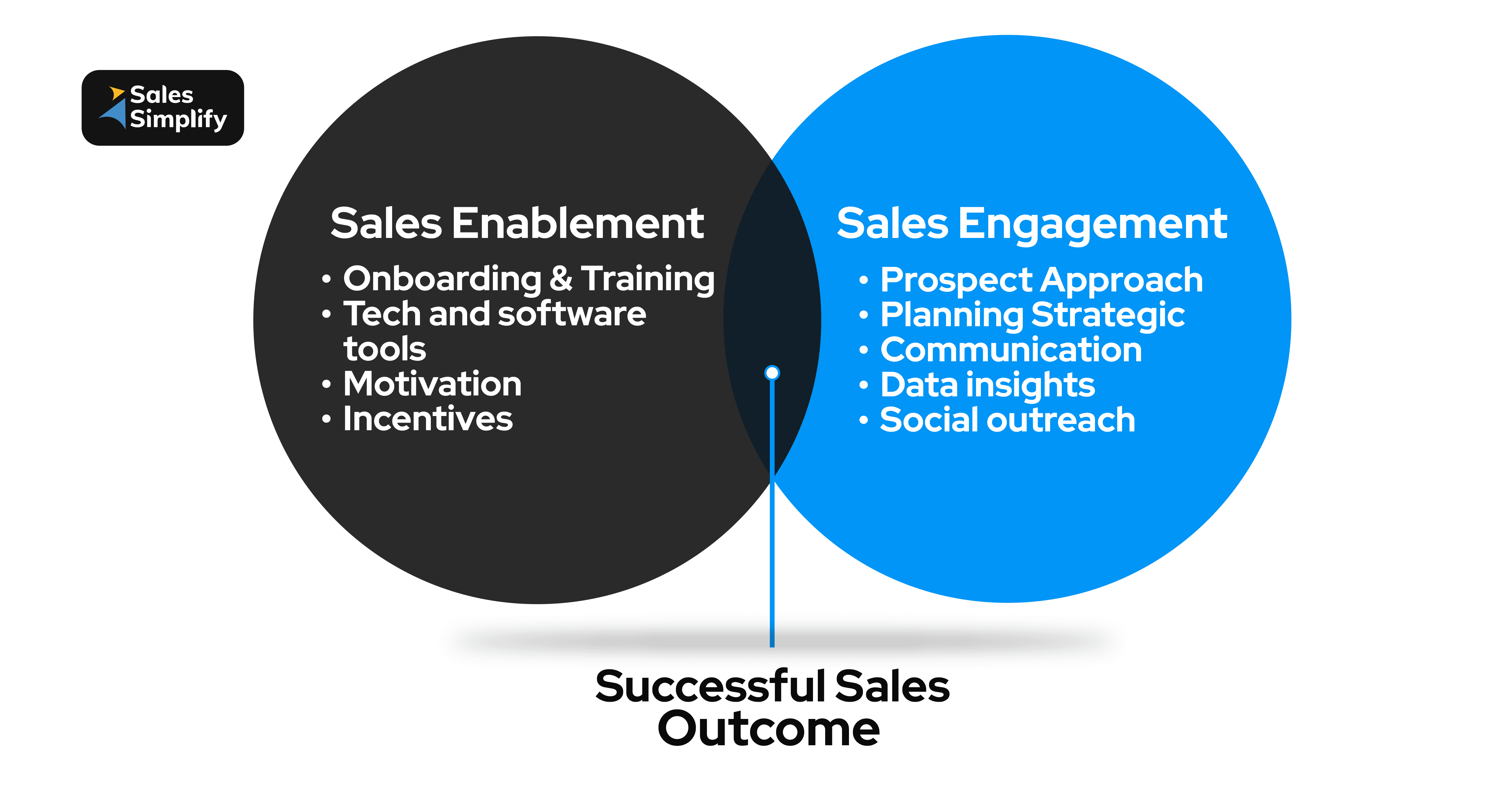
What is a sales engagement platform?
A sales engagement platform is digital software or tool that helps sales reps interact with potential customers.
They can be used to track leads and nurture them, as well as send messages and manage conversations.
Sales engagement platforms help companies to track their sales pipeline, engage with leads more effectively, and make sure that they're interacting with the right prospect/ customer at the right time.
Evolution of sales engagement platforms
People usually get confused between sales engagement platforms vs CRM software. Previously, sales representatives were empowered and trained using marketing automation tools and CRM platforms. Although these tools streamlined the sales process to a certain extent, it wasn't the ultimate solution.
After all, CRM and marketing automation tools weren't uniquely built for the sales engagement process. Businesses armed their reps with CRM systems and marketing automation software to support their efforts.
But then a newer and more advanced technology solely built for sales engagement was introduced in the market – sales engagement platform (SEP). SEP tool offers 360 degrees solutions in the data process.
SEPs offer several functionalities and automation tools that save time. Your sales representatives will have more time to dedicate efforts toward things that require critical thinking.
Sales Engagement tools like Zixflow enhance existing workflows, streamline client and team communications, and improve productivity all under a single umbrella. For example, Zixflow offers sales cadences that you can use to automate your replies and outreach processes.

What to consider while choosing a sales engagement platform?
When selecting a sales engagement platform, keep in mind that not all sales engagement platforms are created the same. Consider the following vital elements before you commit to one:
Easy integration with existing systems
The tool should allow you to integrate your existing sales tools, such as email, CRM, monitoring, storage, and billing software.
You can easily access everything under the same roof with the requirement to switch between myriad tools. The tools should allow you to import data from your existing database.
Strategic outreach tools
A robust sales engagement platform should make the process of reaching and engaging prospects easy.
It should provide your teams with the right gear to track successful and junk leads, navigate easily through the sales engagement process, automate sales actions, schedule follow-ups, execute different campaigns like email marketing campaigns, Whatsapp business marketing campaigns, etc. and much more.
In fact. modern sales engagement platforms like Zixflow allows you to manage all sales engagement activities in one place with built-in sales CRM and automation.
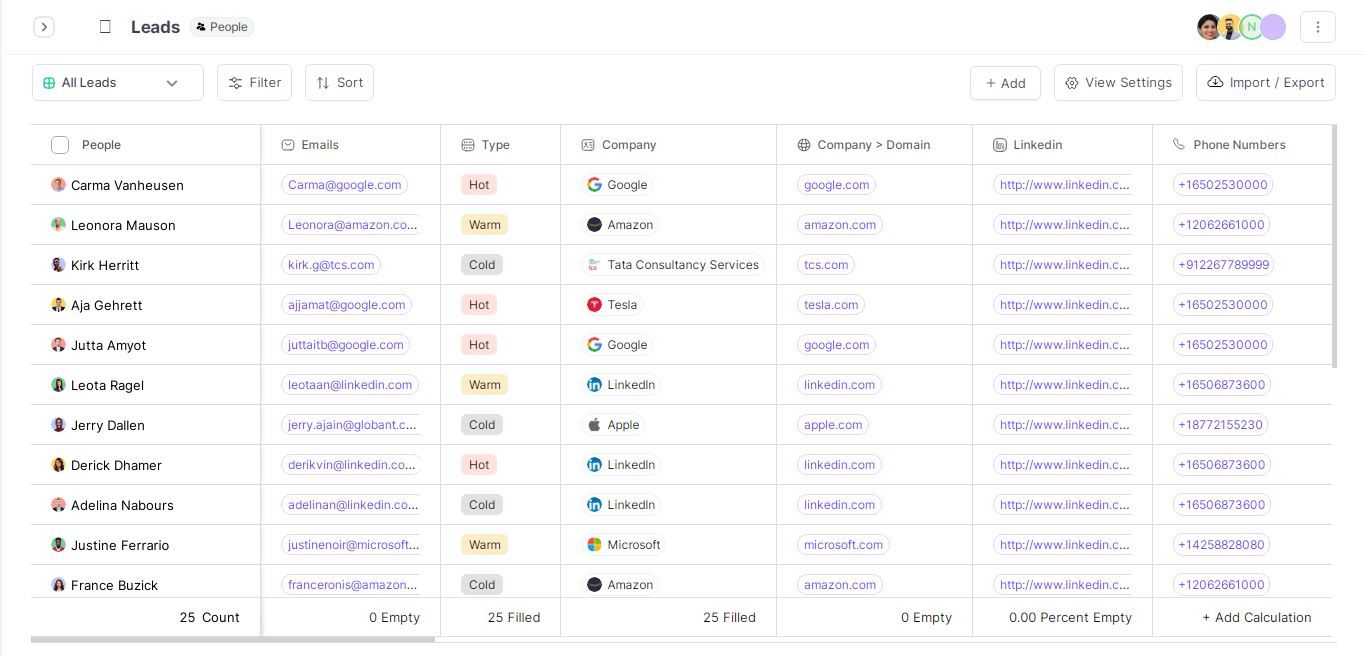
Not just that. Zixflow offers various outreach channels such as email, SMS, and WhatsApp, allowing you to deliver a multichannel customer experience.
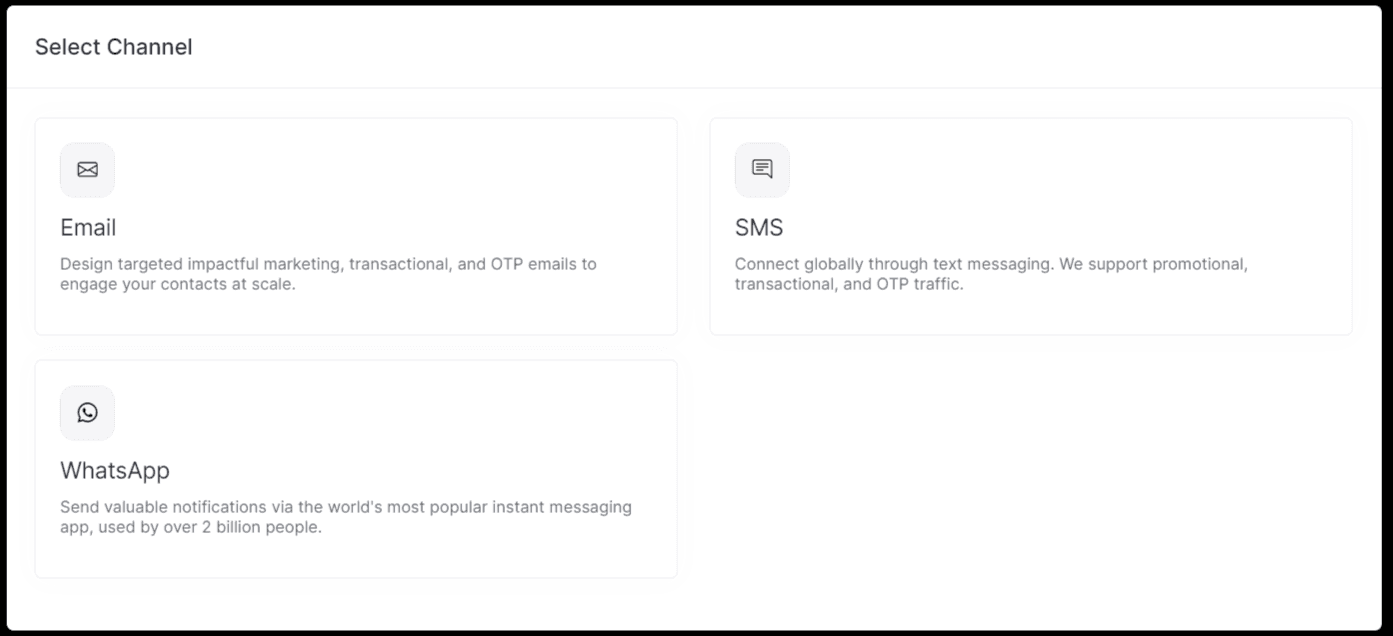
Plus, in the deals tab, you can easily use the drag and drop features to navigate between the pipeline and get a comprehensive view of the deal:

Insightful analytics functionality
Select a SEP that tracks data across individual sales activities. With insightful datasets, your sales team can easily evaluate if they're conducting enough sales activities, whether their sales approach is working, and what elements they need to modify for better outcomes.
In the Zixflow platform, you can customize dashboards, create reports, and include sales targets in the analytics section. Here's a quick overview of the analytics functionalities.
Sales engagement tips and best practices
By now, you must have gotten a pretty good idea about what sales engagement is and its various stages. So, now I’ll go over the steps on how to incorporate the sales engagement process in your company.
Understand your customer and their needs
To ensure a successful conversion through sales engagement, you need two elements of understanding:
- What's your target audience's main point? How can your product address the challenge?
- Making the customers aware of why they need your product. Who else has purchased it? What is the current price offered by the competition? Your product's USP.
Zixflow has a dedicated "notes" section for each lead where you can add important research findings for sales engagement.

Always keep your customers informed
Don't hide information from your customers. Hiding information might backfire with reputational damages in the industry.
Whether there's a policy change, upgradation of the product feature, or modified pricing keep your customers informed.
One way to achieve this is to send informational messages over WhatsApp using the WhatsApp Business Message Templates. WhatsApp has become a go-to communication app and you can use its popularity to inform your customers about important changes.
Provide adequate training to your sales team
No matter how excellent your product or service is, if your sales team isn't up to the mark, you're going to have a hard time making sales. That's why it's important to invest in training your sales team.
Training your sales team differs from one enterprise to another depending on your organizational values and business requirements. But every business should focus on building a sales enablement ecosystem and the following training objectives:
- In-depth knowledge of the product
- Building valuable customer relationships
- The art of closing deals
- Technical expertise to smoothly operate the sales software
- Researching competitors
- Handling objections and criticism.
The best engagement platforms don't just empower your business with software tools. These platforms such as Zixflow also come with a gallery of educational videos to train your SDRs on the basics of sales engagement or other subjects based on your needs.
Address customer concerns quickly
Want to keep your prospects happy? Solve their issues or address their queries at the earliest. A quick resolution will keep them engaged with your company.
Results? Happy and satisfied prospects. They'll be more inclined to purchase your product in the future.
Send personalized follow-up emails
Your research will go in vain if you don’t spice up your emails with personalization. A slight garnish of personal touch can make your prospect feel special and more inclined to invest in the deal.
A report by Statista highlights that email personalization can incredibly improve email open rate by 18.8% and CTR (click-through rate) by 2.1%. Isn’t that a great start for your business?

Sign-up with a community
In the sales engagement realm staying updated is of utmost importance. Being a part of the community helps you with the following:
- Learn personalized hacks for sales engagement
- Connect with sales veterans
- Build your brand
- Get access to the best sales engagement resources
For example, at Zixflow, we help salespeople connect with each other and learn by joining our Sales Accelerator Community. If you want to learn about new concepts of sales and connect with some incredible sales experts, I invite you to join it today!
Real-life sales engagement examples
Several research and industry experts experienced that it takes a minimum of six touch points to make a lead genuinely interested in your product.

With that said, here are a few real-life brands that successfully use sales engagement to achieve business goals.
Example 1: Petco
Petco did an amazing job with their customized “Welcome Message”. Its open rate saw a 50% increase!

Example 2: Prose
Prose did a fantastic engagement outreach with value-based email engagement. Value-based email engagements are great for lead nurturing and improving customer loyalty.

Example 3: Flipkart
Flipkart knows how to nail the email subject line. Crisp, clear, and on-point! As mentioned previously, an enticing email subject line can immensely improve the open rate.
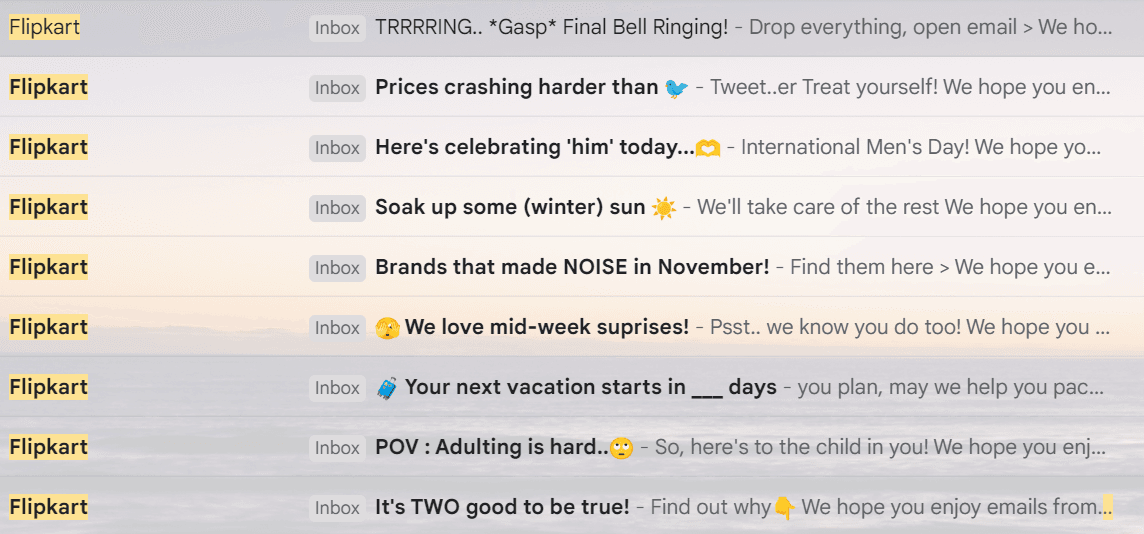
Example 4: LinkedIn
LinkedIn leverages its platform to engage with new prospects and new customers. Similarly, other platforms can also use LinkedIn to present an introductory message about services and offerings. The strategically placed CTAs can be a game-changer!

Example 5: Hotstar
A marvelous sales engagement outreach by Hotstar!! Here they combined hyper-personalization with correct timing to entice leads to sign-up for paid plans.
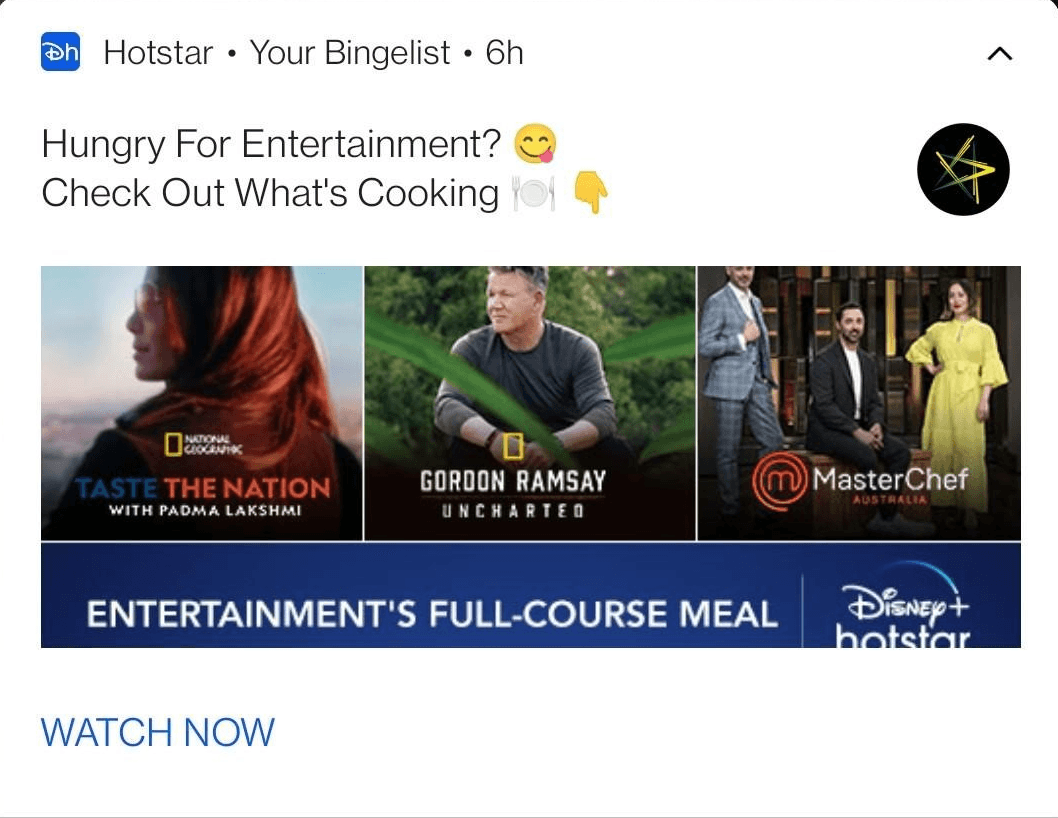
Future of sales engagement
So what does the future of sales engagement look like? Which components of sales engagement should you focus on to improve your outreach efforts? Let’s see.
- Subject line MATTERS. So keep your subject line relevant, crisp, and clever. Data published in Superoffice shows that 33% of people open emails based on the subject line alone.
- Personalizing email subject lines results in a whopping 22% increase open rate
While social media platforms are great choices for lead engagement, email still wins the race. Email is noted to be almost 40 times better at acquiring new customers than popular social media channels such as Facebook and Twitter. (The Brevet Group)
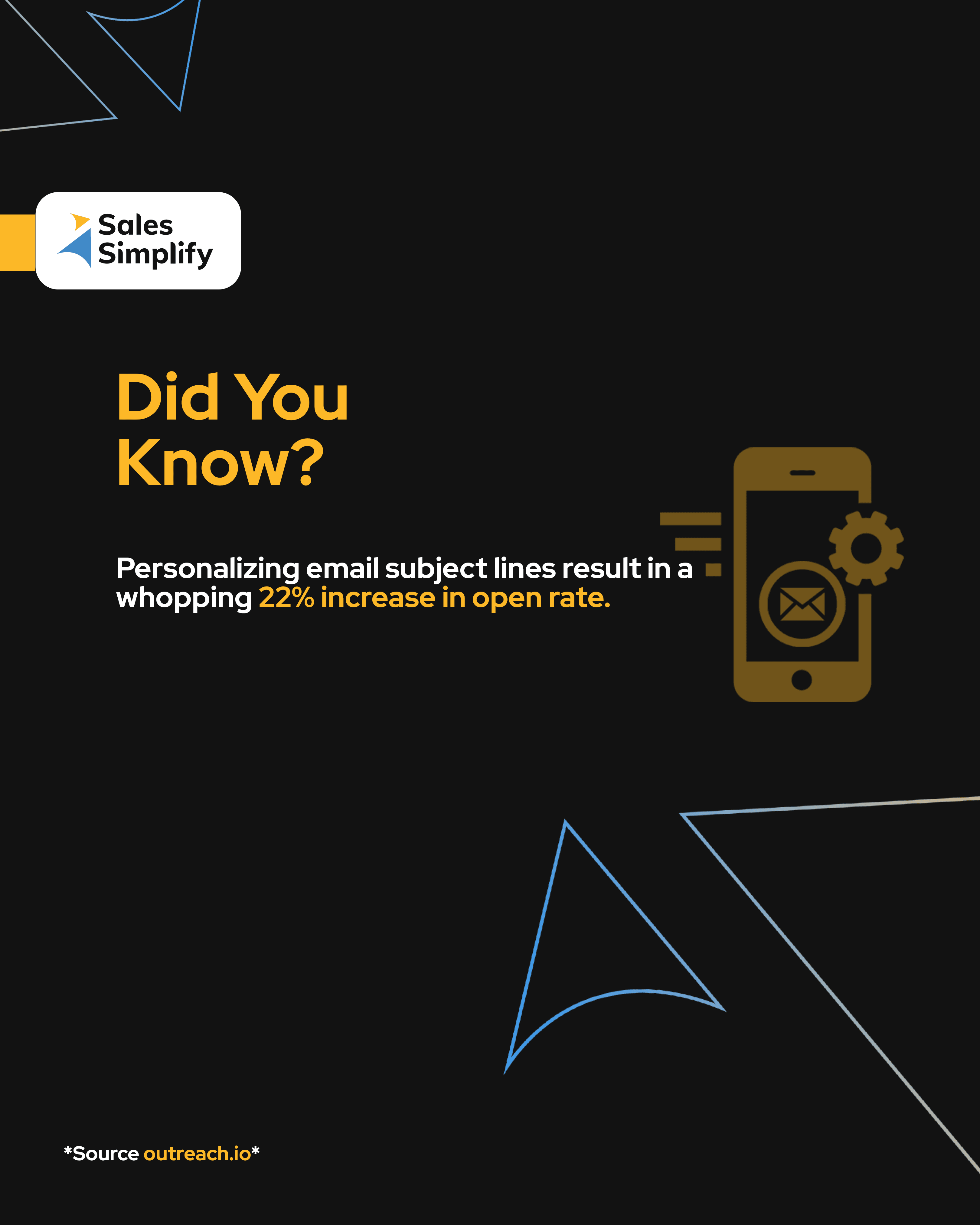
The sales engagement landscape is evolving and transforming. You can leverage these future and trending sales statics to tailor your sales engagement strategy.
Frequently asked questions on sales engagement
Below are some of the commonly asked questions about sales engagement.
Who uses sales engagement platforms?
While sales teams can derive immense value from sales engagement software, the leadership, marketing, customer success, and account management teams can also derive precious insights from the sales platforms.
For example, leaders can evaluate the reasons for the deal loss and implement steps to improve outcomes. Marketing teams can benefit from customer persona research.
Are sales engagement software just fancy sales activity trackers?
The new-age sales engagement platform activity tracking is just the tip of the iceberg. You can do so much more with a sales platform. From importing existing data to automating workflow –- a plethora of features and functionalities awaits to be explored.
What is the difference between sales enablement and sales engagement?
Sales engagement and sales enablement are both important aspects of the sales process. Sales enablement involves supporting and empowering the sales team. But sales engagement deals with cultivating, maintaining, and optimizing customer interactions.
Sales engagement improves prospect-seller bonding through strategic communication, data-driven insights, and feedback.
Overcome your sales engagement roadblocks with a robust sales engagement process
Having a smooth sales engagement process in today’s dynamic landscape is crucial for business success. In this guide, I have explained the key components that contribute to effective sales engagement, resulting in more conversions.
We have also seen how sales engagement software can help you simplify your sales process and learned of many instances where Zixflow can assist you.
It provides you with many practical features such as activity creation and tracking, task execution, sales cadence automation, analytics, and multi-channel integration.
Your sales reps can use these capabilities to create valuable one-on-one conversations throughout the potential customer's journey—and do it seamlessly at scale.
So, if you're still wondering about how to empower your sales team for better engagement, try Zixflow for free!
